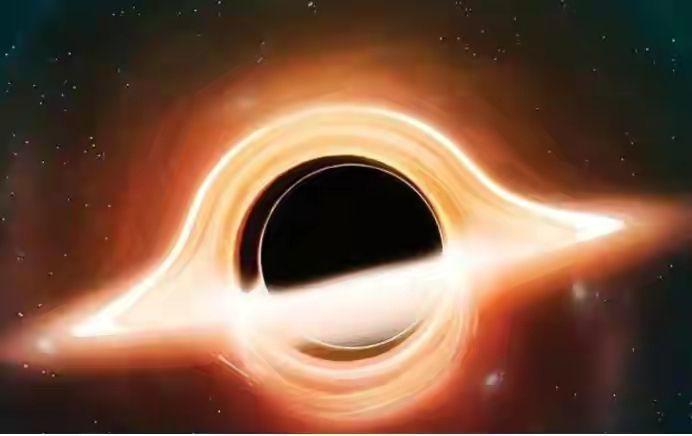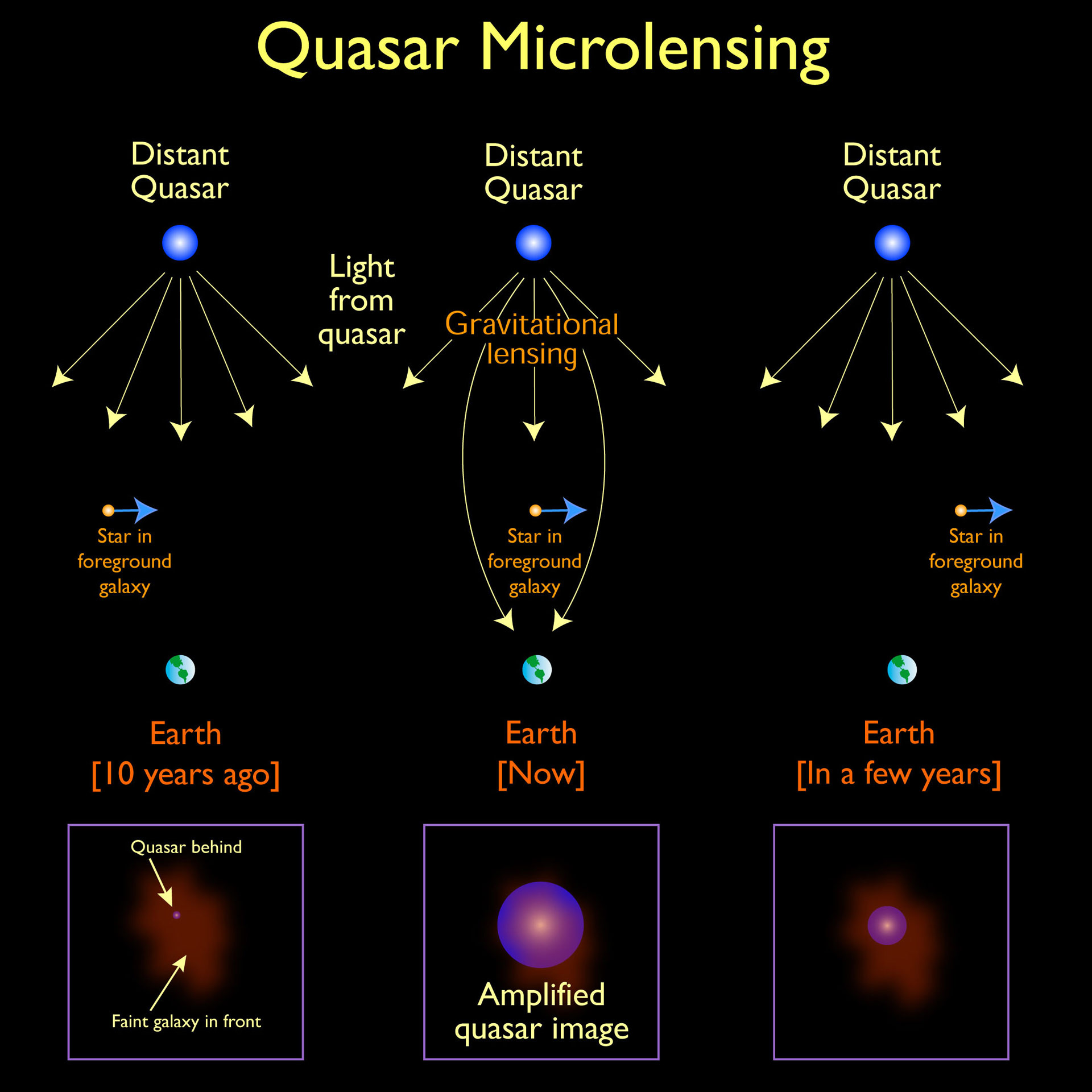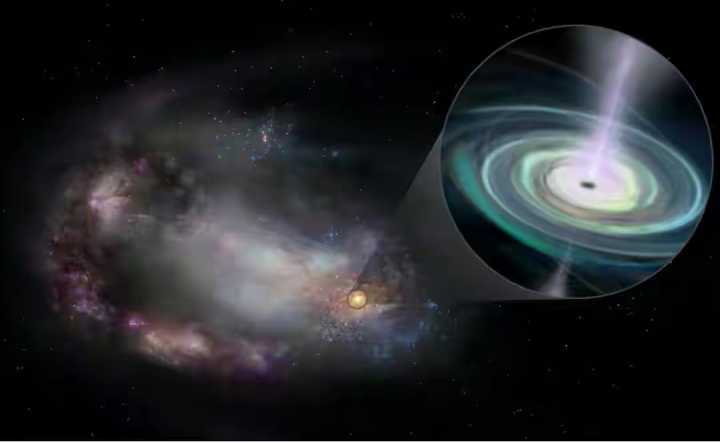The first 'wandering black hole' was discovered, 7 times as massive as the sun, and it took scientists 6 years to observe it
Black holes are a special form of celestial body in the universe, do not emit light, do not reflect light but absorb light, however we rely on electromagnetic waves like light to observe celestial objects in the universe. pillar. So seeing the black hole is very important. Usually only when the black hole's gravity acts on other objects, or when the black hole absorbs the matter of other objects to form an accretion disk.

Black holes have accretion disks, commonly known as quasars.
However, on February 5, an announcement from the "Organizational Network of Physicists" said that an international astronomical research team had discovered a "roaming black hole" through the phenomenon of "microlensing". " - an astronomical phenomenon due to the gravitational lensing effect. It can be used to detect objects that range from the mass of a planet to the mass of a star, regardless of the light they emit - This is a way to explore guinea pigs ladder.

The team of astronomers analyzed the data they collected and came to the conclusion that the object could be a black hole, not a star. They even calculated its approximate mass to be 7.1 times that of the sun. The black hole is named MOA-2011-BLG-191/OGLE-2011-BLG-0462.
Although this news has only recently been reported, the discovery was made in 2011, when the team discovered a lonely black hole moving between stars. This 'wanderer' has formed a 'microlensing' with gravity so strong that it can bend and twist the light of the stars and galaxies behind it. And this is also considered to be the first wandering black hole observed.

The "microlensing" effect refers to the phenomenon where a celestial body has a strong gravitational field that causes the background light of the object behind it to be distorted. And the distribution of gravity in the universe is very uneven, when the gravitational field is strong, electromagnetic waves such as light rays will be distorted by the gravitational field, which forms a kind of gravitational lens. The light of the celestial background is refracted through this lens, the shape will be bent, the position will be shifted, and the brightness will also decrease. So even if the object causing the gravitational lensing cannot be seen, its existence can still be sensed, even if the object is a black hole, that's why "black hole languishes". ladder" is detected.

This black hole is 5,153 light-years away, in the Milky Way, and has a mass 7 times that of the sun. It is passing nearby stars at about 45 km/s, or about 162,000 km/h. Scientists also believe that there are many similar stellar wandering black holes, but because the black holes themselves do not emit light, and the micro-lensing effect is not easy to detect, so the wandering black holes not easily observed. In fact, it's much harder to observe than roaming stars or even roaming planets.

The team started observing this wandering black hole in 2011, when scientists only discovered that a star's brightness increased for no reason, when they assumed it was due to activity. motion of the star itself.
Through continuous observation, they found that this did not happen after continuous monitoring. Over the course of 6 years, through the strange changes in the brightness and position of the star and its surroundings, they determined that this was definitely caused by the microlensing effect. They therefore believed that the light emitted by the star was blocked in front of it (closer to the direction of the observer) by an invisible object that was bent, and because the object was invisible, so it is considered a black hole. It was then evaluated by various factors and concluded that this was definitely a wandering black hole.
Black holes of this mass are usually formed by supernova explosions of massive stars, but they can also be formed by the direct collapse of massive stars, so they commonly known as stellar black holes. Astronomers hypothesize that there are at least 1 million to 100 million such black holes in the Milky Way.

In fact, wandering black holes are very dangerous for planets that have life in the universe or have developed civilizations, because they are difficult to observe and their gravity is so strong. If there were such a black hole near the solar system, at our current human level, we would not be able to perceive its existence, and of course, we would be wiped out.
You should read it
- Explaining the mysterious gravity loss phenomenon in some places in Canada?
- How fast can a rocket fly to win gravity and escape the Earth?
- Isaac Newton discovered that the gravitational force of a falling apple was anecdote
- Decode the ball mystery itself 'climb the slope' at the 'non-gravity' hill
- If you want to be a data scientist, learn these 3 languages right away!
- An 'alien' object will fly over Earth in 2017?
- Experimental science proves that gravity is still effective at 50 micrometers
- Use the Sun's gravity to transmit interstellar signals
May be interested
- A 'hungry' black hole has just woken up and started swallowing surrounding matter
 at the center of most galaxies lurks a giant monster: a supermassive black hole with a mass tens of thousands to millions of times that of the sun.
at the center of most galaxies lurks a giant monster: a supermassive black hole with a mass tens of thousands to millions of times that of the sun. - The mysterious history of black holes has been decoded by scientists
 one of the common misconceptions about black holes is that they not only swallow matter, but also the history of that matter. the truth about the history of black holes in the universe has finally been revealed.
one of the common misconceptions about black holes is that they not only swallow matter, but also the history of that matter. the truth about the history of black holes in the universe has finally been revealed. - Black force - a new force in the universe, becomes even more strange
 this finding could affect how we simulate the formation of stars and planets, and even help us discover a theoretical form of radiation that explains the black hole's death (flight black hole).
this finding could affect how we simulate the formation of stars and planets, and even help us discover a theoretical form of radiation that explains the black hole's death (flight black hole). - The discovery of a giant black hole, 70 times the mass of the Sun in the Milky Way, challenges every theory
 the existence of this giant black hole shocked researchers because it contradicted previous cosmological theories.
the existence of this giant black hole shocked researchers because it contradicted previous cosmological theories. - Detecting an unusual object lurking in our Galaxy, possibly a black hole
 if scientists can accurately prove the existence of this object with more in-depth studies in the future, it will become the second largest black hole found in our galaxy.
if scientists can accurately prove the existence of this object with more in-depth studies in the future, it will become the second largest black hole found in our galaxy. - Detecting an active supermassive black hole at an unprecedented distance
 normally, a typical black hole can have about 10 times the mass of the sun. however, supermassive black holes are usually much heavier.
normally, a typical black hole can have about 10 times the mass of the sun. however, supermassive black holes are usually much heavier. - Successfully creating cosmic black holes, demonstrating Hawking radiation exists
 to successfully create the space black hole in the laboratory, a smaller and more gentle version of the scientists used the ultra-cold gas of more than 2,000 atoms. people have made great strides in studying the mysteries in the universe. scientists hope in the future we can capture the power in the universe.
to successfully create the space black hole in the laboratory, a smaller and more gentle version of the scientists used the ultra-cold gas of more than 2,000 atoms. people have made great strides in studying the mysteries in the universe. scientists hope in the future we can capture the power in the universe. - The streams of plasma sprayed from black holes can kill anything
 the plasma flow from the black hole produces a large amount of radiation, especially high-energy x-rays and gamma rays, which can destroy anything on their path.
the plasma flow from the black hole produces a large amount of radiation, especially high-energy x-rays and gamma rays, which can destroy anything on their path. - This is what you would see if you fell into a black hole
 no one knows what will happen when falling into a supermassive black hole like a black hole. to answer this question, nasa researchers created a simulation using the discover supercomputer at the nasa climate simulation center depicting what would happen when falling into a supermassive black hole like a black hole. at the center of the milky way.
no one knows what will happen when falling into a supermassive black hole like a black hole. to answer this question, nasa researchers created a simulation using the discover supercomputer at the nasa climate simulation center depicting what would happen when falling into a supermassive black hole like a black hole. at the center of the milky way. - Hear the Sound of a Black Hole Through NASA Sonification
 black holes are some of the most extreme objects in the universe. these massive, incredibly dense objects have such a strong gravitational pull that they pull in anything that gets too close – even light.
black holes are some of the most extreme objects in the universe. these massive, incredibly dense objects have such a strong gravitational pull that they pull in anything that gets too close – even light.










 Discover the 'unbeatable' 2D material: Light as plastic and stiffer than steel
Discover the 'unbeatable' 2D material: Light as plastic and stiffer than steel These are the 9 equations that changed the world, how many can you understand?
These are the 9 equations that changed the world, how many can you understand? 10 strange creatures found in the deep sea in 2021
10 strange creatures found in the deep sea in 2021 NASA successfully launched the James Webb space telescope, a 'time machine' that gives us a look into the past of the Universe
NASA successfully launched the James Webb space telescope, a 'time machine' that gives us a look into the past of the Universe Top 10 rare cat species in the world
Top 10 rare cat species in the world 11 interesting and quirky historical facts that make everyone think it's a joke
11 interesting and quirky historical facts that make everyone think it's a joke